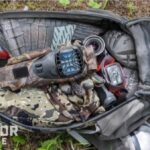Walkie talkies should be used by anybody who ventures into the wild with a friend.
Voices don’t carry very far in the woods, and emergency whistles are easily lost. Plus, they only say one thing:
“FWEEEEEEE!”
Two-way radios, on the other hand, facilitate long-range communication.
Do you see some deer headed toward your hunting partner? Tell him about them!
Do you need to head back to the cabin? Why not radio out and ask people if they need snacks?
And, of course, a walkie talkie is indispensable in an emergency. If you fall and break a leg, shouting is unlikely to bring help. A radio, however, will let you inform your group of your location and plight.
Read our reviews and consider one of the radios below, and don’t lose communication with your fellow hunters.

Don’t have much time? Consider the Midland GXT1050 for hunting, Motorola T600 H2O Talkabout for fishing, and the Cobra CXT195 if you need to walk and talk on a budget!
DISCLOSURE: As an Amazon Associate I earn from qualifying purchases. Links in this article are affiliate links. If you click on a link we may earn a commission if you make a purchase, at no additional cost to you.
The 7 Best Walkie Talkies: Outdoor Empire Reviews
- Best for Hunting: Midland GXT1050VP4
- Best Budget Pick: Cobra CXT195
- Best Long-Range: Midland GXT1000VP4
- Best for Large Groups: Retevis RT22
- Best for Hearing Protection: Walker’s Razor Attachment
- Best Waterproof: Motorola T600 H2O Talkabout
- Best Durable: DeWALT DXFRS800
| Category | Best for Hunting | Best Budget Pick | Best Waterproof |
|---|---|---|---|
| Product | 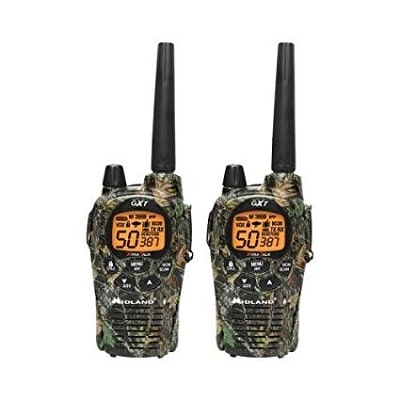 Midland GXT1050VP4 | Cobra CXT195 | Motorola T600 H2O Talkabout |
| Range | 36 miles | 16 miles | 35 miles |
| Channels | 22/50 | 22 | 22 |
| Privacy Codes | 142 | None | 121 |
| Batteries | Rechargeable battery pack or 4xAA | 3xAAA rechargeable | Rechargeable battery pack or 3xAA |
| Water Resistance | JIS4 | None | IP67 |
| Cost | Check Price | Check Price | Check Price |
1. Best Hunting Walkie Talkies
The Midland GXT1050VP4 is a GMRS-only radio with a maximum range of 36 miles when using the maximum amount of power allowed by the law.
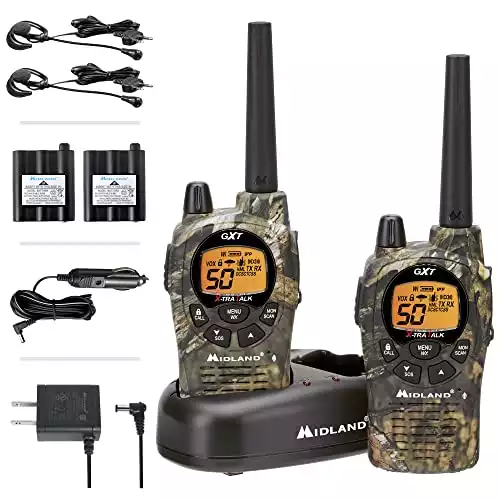 Midland GXT1050VP4
Midland GXT1050VP4
- Animal calls, weather alerts, whisper mode, and other hunting features
- Voice activation for easy use
- Waterproof
- Dumb battery charger, though you can also use AA batteries
- Requires GMRS license to legally use the higher power levels
Specs
- Range: 36 miles
- Channels: 22/50
- Privacy Codes: 142
- Batteries: Rechargeable battery pack or 4xAA
- Water Resistance: JIS4
- FRS/GMRS? GMRS only
- Misc: Animal calls, NOAA weather alerts, SOS siren, and VOX
- Package Includes: Batteries, headsets, belt clips, desktop charger, and AC and DC adapters
Overview
If you don’t need that much power, then you can use the medium and low power settings.
There are 22 channels and 28 extra channels, as well as privacy codes for all of them. You can even monitor two channels at once.
Many walkie talkies are good for taking with you when hunting. The Midland GXT1050VP4 is, itself, a good hunting tool.
That’s because, while most radios focus on communication, the GXT1050VP4 has several hunting-only features. Most useful is the set of five animal calls:
- Cougar
- Crow
- Duck
- Turkey
- Wolf
Depending on what you’re hunting, you may not need to bring a separate animal call!
Also, there’s a silent mode to prevent any external sound. That way, an incoming transmission won’t spook the animal in your sights. There’s also a whisper mode so you don’t have to speak at your normal volume into the mic.
And, if you get in trouble, you can hit the SOS Siren to spook off a cougar or let your hunting buddies know you need help.
The biggest downside to this radio is the charger. It doesn’t automatically turn off when the battery is full!
2. Best Budget Walkie Talkies
Cobra’ CXT195 radios are inexpensive walkie talkies that work much better than you’d expect but will not stand up to harsh weather by themselves
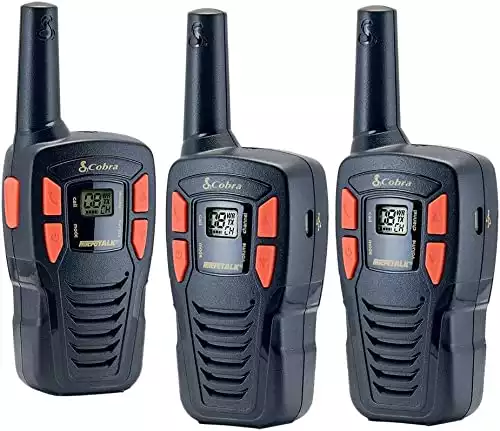 Cobra CXT195
Cobra CXT195
- Small and lightweight so they won’t drag down your hunt
- Quite inexpensive for a quality walkie talkie
- The included rechargeable batteries are not great, so you may want to replace them
- Relatively short range
Specs
- Range: 16 miles
- Channels: 22
- Privacy Codes: None
- Batteries: 3x AAA NiMH rechargeable batteries
- Water Resistance: None
- FRS/GMRS? Both
- Misc: Weather radio, call alerts, Roger Beep
- Package Includes: Batteries, USB charging cable
Overview
The screen on each CXT195 radio is rather small. There are not a lot of features in each radio, but that’s good for hunters, hikers, and fishers on a budget, since you won’t be paying for advanced technology you may not use.
What you do get is a maximum range of 16 miles, 10 weather radios to keep you safe, 5 customizable call alerts so you know who’s talking, and a Roger Beep that tells everyone when you’re done talking.
Cobra also includes a nifty power-saving circuit that saves your battery life when you’re done transmitting.
Please note that these are small radios. Smaller than you’d expect.
This does make them lightweight and easy to pack, so it’s an overall positive. Just don’t expect big ol’ walkie talkies if you buy these Cobras!
3. Best Long-Range Walkie Talkies
Five watts is the maximum amount of power legally allowed for hand-held radios to transmit in the United States. Few walkie talkies are that powerful. The Midland GXT1000VP4 is one of the few that is.
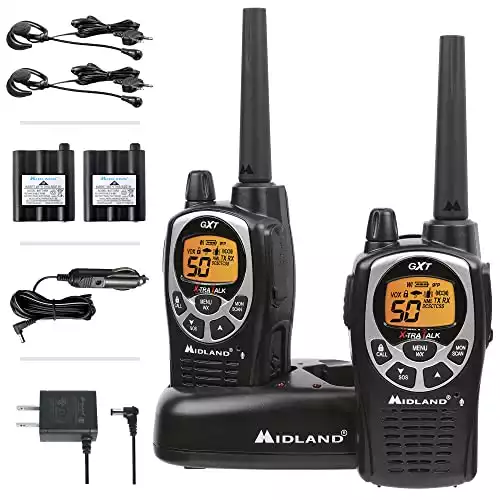 Midland GXT1000VP4
Midland GXT1000VP4
- 5-watt power for the longest-range transmissions legal with GMRS bands
- Weather resistant & has NOAA weather scanning plus alerts
- Lacks range when not using the rechargeable battery, which requires using the dumb battery charger
- Short battery life
Specs
- Range: 36 miles
- Channels: 22/50
- Privacy Codes: 142
- Batteries: Rechargeable battery pack or 4xAA
- Water Resistance: JIS4
- FRS/GMRS? Both
- Misc: NOAA weather alerts, SOS siren, and VOX
- Package Includes: Batteries, headsets, belt clips, desktop charger, and AC and DC adapters
Overview
It’s very similar to the already-reviewed GXT1050VP4 but with a few important changes. Specifically, you lose out on the animal calls. However, you do gain the ability to transmit via FRS, which doesn’t require a license.
However, you still need that GMRS license to get the full benefit of this radio’s range. You also won’t get a full 5 watts of power unless you use the rechargeable battery pack.
That battery pack provides up to 11 hours of battery life, so these aren’t your best choice for extended forays. Still, they might be a good backup to shorter-ranged walkie talkies.
4. Best Walkie Talkies for Large Groups
Not everyone involved in outdoor sports want to know how to program a walkie talkie, and that’s okay. The Retevis RT22 comes in a 6-pack so you can outift your entire family or a large hunting group with a light and effective radio.
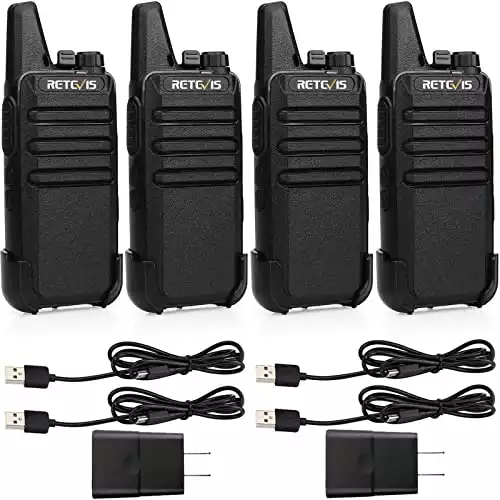 Retevis RT22
Retevis RT22
- Comes in a 6-pack and includes a 6-position charger
- Easy to set up and use, even by people who don’t like radios
- Slim and light for easy portability
- No real water resistance, only dust proofing
Specs
- Range: Short
- Channels: 16
- Privacy Codes: None
- Batteries: Li-ion 1000mAh rechargeable
- Water Resistance: IPS4
- FRS/GMRS? FRS
- Misc: Voice activation, emergency alarm, channel lock
- Package Includes: Batteries, six-way charging station, and belt clips
Overview
The RT22 weighs 4 ounces and is smaller than many cell phones so you won’t have to hit the gym before loading them up before your trip.
If you’re hunting with a child and they, like I was at that age, love experimenting with their tools, you can turn on a channel lock so they stay in contact with you.
There’s also an emergency alarm so your newest hunting buddies can signal for help from anywhere.
The RT22 isn’t a waterproof radio but it’s small enough to fit in a waterproof bag or under your rain jacket.
I’ve worn radios under my rain jacket for work and the RT22 is slim enough to not be as annoying as some of those beasts that have dragged down my pants!
However, the RT22 is fairly weak and is only able to put out 2 watts of power at maximum strength.
You shouldn’t be getting too far away from your outdoor newbies, though.
5. Best Hearing Protection Walkie Talkies
A big problem with using a radio while hunting is that guns are loud. And no deer I’ve met has been polite enough to wait still while I slip on my hearing protection.
One solution is to use active hearing protection and hope that holding a walkie talkie close to your active ear muffs doesn’t cause them to buzz out.
Another solution is to use headphones with a built-in radio. Walker’s gives you this solution with the Razor Walkie Talkie attachment.
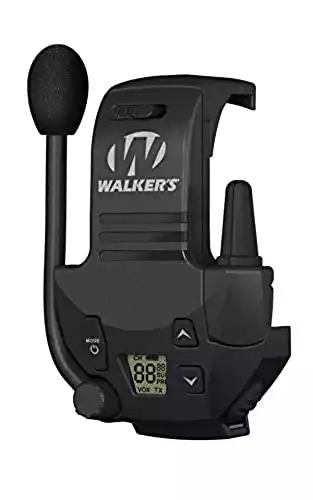 Walker’s Razor Walkie Talkie Attachment
Walker’s Razor Walkie Talkie Attachment
- Hands-free communication
- Works with hearing protection, which you should be wearing while shooting even while hunting
- The boom mic has a weak point so be careful when raising or lowering it
Specs
- Range: 3 miles
- Channels: 22
- Privacy Codes: 99 “sub channels”
- Batteries: 3x AAA
- Water Resistance: Not stated
- FRS/GMRS? FRS
- Misc: Boom mic, VOX
- Package Includes: Batteries, belt clips, dual charger, charging adapter, and emergency preparedness checklist
Overview
This is basically a handheld radio that attaches to the side of a Walker’s Razor Slim or Razor Digital earmuff, complete with antenna, controls, and boom mic.
The VOX feature makes it easy to talk to your partners no matter what you’re doing.
The mic has dynamic wind filtering capability to help transmit your voice clearly.
AAA batteries run the radio for up to 12 hours, which is somewhat short, so you may want to carry spares.
The biggest weak point of this radio is a literal weak point:
The boom mic can break if subjected to too much stress while moving it. I recommend moving the knob it’s mounted to, not the boom itself.
Oh, do you not have a Razor Slim or Razor Digital on which to mount these walkie talkies?
You can buy a combo pack with two Razors and two walkie talkies!
6. Best Waterproof Walkie Talkies for Fishing
The Motorola T600 H2O Talkabout is a rugged, waterproof radio designed to float if it falls in the water. The brightly colored case helps you spot and retrieve it from the water.
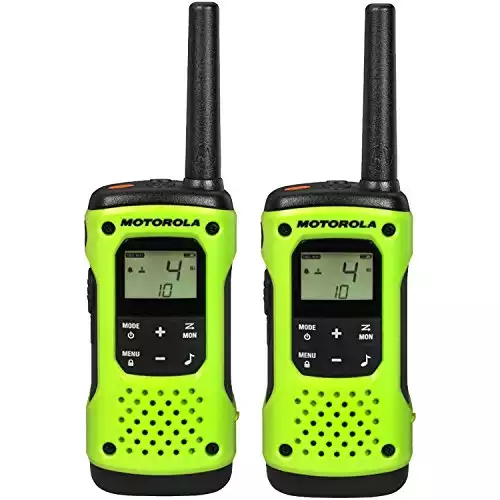 Motorola T600 H2O Talkabout
Motorola T600 H2O Talkabout
- Plenty of hunting- and fishing-friendly features
- Waterproof enough to float and has a water-activated LED light for easy retrieval
- The water sensors are very sensitive and can turn on even in pockets with a bit of condensation, draining the battery
- Relatively short range in real-world conditions
Specs
- Range: 35 miles
- Channels: 22
- Privacy Codes: 121
- Batteries: NiMH rechargeable battery pack or 3x AA
- Water Resistance: IP67
- FRS/GMRS? Both
- Misc: Floating design, NOAA weather alerts, water-activated flashlight with both red and white LEDs, and VOX
- Package Includes: Batteries, belt clips, and power supply with Y charging cable
Overview
Rubber armor protects your radio from drops, and the design is also dustproof.
There is a built-in NOAA weather receiver and alert system to warn you of incoming inclement weather. You also get to use the standard 22 FRS/GMRS channels.
An LED flashlight helps you if it gets dark. There are actually two LEDs. One is red, to help preserve night vision. The white LED automatically turns on when the radio detects water to help you recover the walkie talkie if you drop it in the river.
You can recharge the batteries or use normal AAs if you need to replace them in the field.
VOX technology allows for hands-free transmissions, and VibraCall vibrates when the radio is receiving so you don’t miss a call due to a nearby waterfall. Plus, there’s an emergency alert for if you fall in!
You can also turn on a keypad lock so your radio doesn’t accidentally swap channels when you bump into a tree on your way to your favorite fishing spot.
See Also: Motorola Talkabout T800 vs T801 Hands-on Review
7. Most Durable Walkie Talkies
The DeWALT DXFRS300 is a radio designed to withstand the toughest of terrain, including mountains and construction sites.
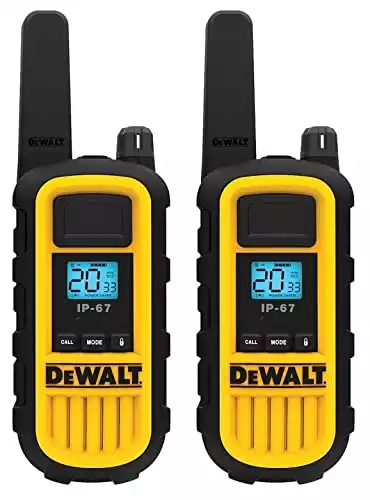 DeWALT DXFRS800
DeWALT DXFRS800
- All-day battery life so you don’t have to worry about losing your hunting partner come evening
- Waterproof, dustproof, and shockproof to withstand accidents that would shatter other radios
- Lacks emergency features, such as weather channels or a flashlight
- Poorly-designed belt clip
Specs
- Range: 300,000 sq. ft. / 25 floors
- Channels: 22
- Privacy Codes: 121
- Batteries: Lithium Polymer rechargeable battery
- Water Resistance: IP67
- FRS/GMRS? FRS
- Misc: Power saving mode, shock resistant, and VOX
- Package Includes: Batteries, dual charger, and charging adapter
Overview
It’s also a surprisingly good hunting radio thanks to the silent vibrating alert, anti-slip design, and power saving mode. These walkie talkies can stay on for 18 hours when standing by 90% of the time.
The DeWALT DXFRS800 is not only dustproof and waterproof, but it’s also shock resistant. It can withstand 2-meter drops onto concrete without damage.
You can use the included charging station or plug the radio into a wall charger. It’s also compatible with headset and earbuds, though the package doesn’t contain any.
The biggest weakness of the DeWALT DXFRS800 is the belt clip, which isn’t as strong as the rest of the unit.
It’s also bright yellow, which can be a mixed blessing.
The color is bright enough to stand out so, if you want maximum camouflage, you’ll need to cover up the radio.
However, the yellow also functions as a don’t-shoot warning!
Related: Rocky Talkie vs BCA BC Link Walkie-Talkie Comparison
Walkie Talkie Overview
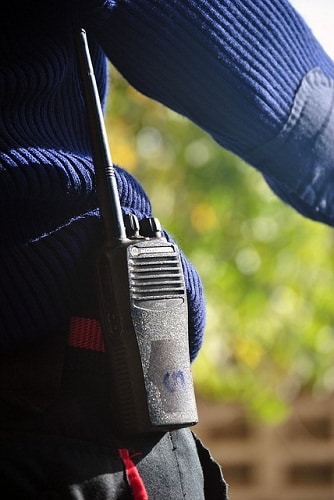
What ARE walkie talkies, anyway? And what makes them different from radios?
To be exact, walkie talkies are UHF handheld radio audio transceivers.
“Transceiver” means that they can both transmit and receive radio signals, which is why they are also called two-way radios. This is opposed to the radio in your alarm clock, which can only receive.
“UHF” means “ultra-high frequency.” This refers to the 462 to 467 MHz frequencies they broadcast. Those frequencies are blocked out for FRS and GMRS use, which will be explained later.
“Handheld” should be self-explanatory. They’re not mounted to a vehicle or building, nor are they backpack two-way radios.
Walkie talkies default to receive mode, which is when the receiver is on and listening for a signal. Once a signal is received, then the radio turns the signal into audio for the speaker.
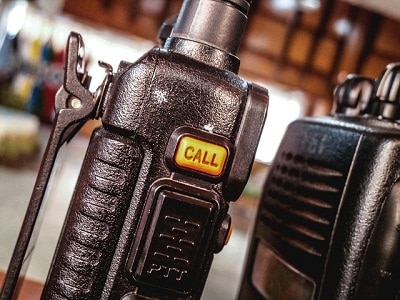
When you press the push-to-talk button, the transmitter turns on and the receiver turns off. Because of this, only one person can talk at a time. The signal propagates throughout the entire range of the radio signal and any radio in the vicinity set to that channel will receive the signal.
Once you release the PTT button, the radio ceases transmitting and enables receiving again.
UHF radio waves basically work over line-of-sight. They can penetrate some light obstacles, such as thin tree cover, but at longer ranges you need to see the recipient in order for them to receive your signal.
How to Choose A Walkie Talkie?
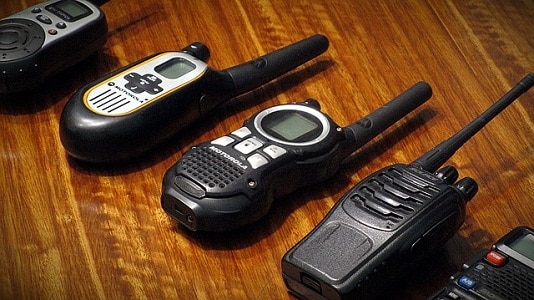
Walkie talkies come in many sizes and powers. All of the radios you read about above are good for hunting, but some are better under different circumstances.
So, let’s learn more about various walkie talkie features which can make a certain model a good or poor choice!
FRS and GMRS
First of all, a note about legality.
The FCC has created two personal-use systems, the FRS and GMRS.
FRS—Family Radio Service
Most people using walkie talkies will broadcast using the FRS. This system uses a specific set of frequencies and can be used by anyone for radio use, though other uses are prohibited.
So, if you’re designing a radio-controlled drone, don’t use an FRS frequency!
The only “problem” with the FRS is power. The FCC limits the amount of power you can use to broadcast on an FRS frequency to 2 watts.
GMRS—General Mobile Radio Service
The GMRS uses similar-yet-different frequencies to FRS. The main benefit of using GMRS is that you can use more than 2 watts of power. Transmission can use up to 5 watts, allowing for a much greater range, though not 2.5 times the range.
However, you need a GMRS license with the FCC to legally broadcast on GMRS channels. The FCC is unlikely to prosecute radio piracy in emergency situations, but it’s still highly recommended for you to acquire a GMRS license if you want to use those frequencies.
Channels
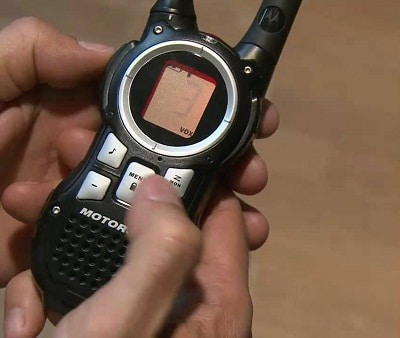
Walkie talkies these days are much easier to use than in the dark days of radios. Channels are, for the most part, standardized, and you can almost always communicate with any FRS/GMRS radio with any walkie talkie.
On 22-channel walkie talkies, 8–14 are typically FRS channels, while 1–7 and 15–22 are GMRS channels.
Some radios, however, have programmable channels. These are typically UHF radios which can use frequencies past those allotted to the FRS and GMRS systems. However, you’ll need a more expensive business license to use those frequencies!
Privacy Codes
You can also use privacy codes so other people listening to your channel won’t hear what you say, only the intended recipient.
Radios with privacy codes transmit a certain code with their messages, and receiving walkie talkies will remain unmuted unless they are set to that same code.
This provides a measure of privacy, though it’s not perfect.
Range and Power
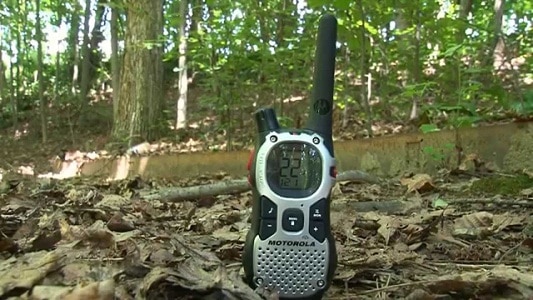
As mentioned before, FRS radios broadcast at up to 2 watts of power and GMRS radios can use up to 5 watts of power.
It takes an ever-increasing amount of power to push the radio signal just a little bit further, so max-power GMRS has only a little more range than max-power FRS.
Many walkie talkies claim a range of over 30 miles. Sounds impressive, right?
Well, you won’t get that far unless one of you is on a mountain and the other in a valley, AND you can see each other!
The real-world range will be much shorter. A 35-mile radio may reach 7 miles across a flat field and 2 miles in a forest or suburban neighborhood.
So, while extra power does grant you extra range, it also comes at the expense of a much shorter battery life. If you expect a range of one mile then you’ll be satisfied with the range of all of the walkie talkies above.
Oh, and radio waves don’t propagate well through solid objects, so don’t expect your radio to work well when your friend is on the other side of a hill.
Battery Life
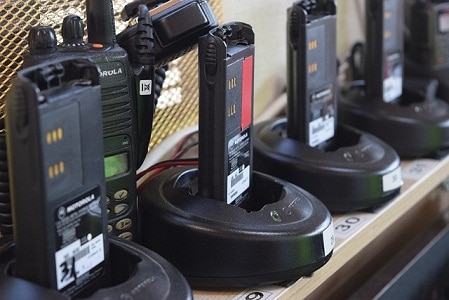
Battery life is both very important and not all that important when it comes to walkie talkies.
A longer battery life will keep you on the air longer before needing to recharge your batteries. However, most walkie talkies can also use AA batteries, and good luck getting to a wall charger in the mountains!
Still, if you have room for the gear, it might be a good idea to carry two radios. One short-range radio for battery life, and a long-range radio for if you get separated from the group and cannot raise them on the other radio.
Durability and Waterproofness
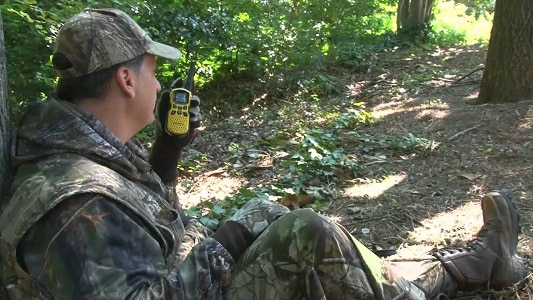
Rugged walkie talkies cost more than less-protected walkie talkies. However, if you’re camping, hiking, hunting, kayaking, or engaging in any other outdoor activity, improved durability could mean the difference between contacting your partner and holding a dead radio.
As for waterproofness, you don’t always need to pay for that feature. Waterproof radios tend to have a lower maximum volume and cost more. They’re good when you’re on a river, but if you’re in the woods, water resistance is good enough against rain.
Extra Features
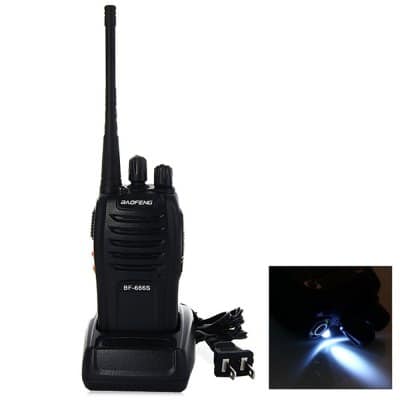
Most radios come with more features than just transmitting and receiving radio signals.
As an outdoors person, certain extra features are good to have.
Weather alerts? Those can save your life!
Emergency flashlight? You should have a flashlight with you already, but two is better than one!
Some other features are conveniences, such as headsets and VOX.
Whether you want these are up to you. Personally, I won’t buy a walkie talkie without a weather radio.
VOX
The word “VOX” means “voice-operated exchange”.
What this means is that, when you are in VOX mode, you can start talking and the radio will start transmitting! No need to use the push-to-talk button.
VOX can be a bit finicky but many people prefer to use VOX radios when they might have their hands full due to the convenience.
Please note, however, that VOX radios do take some time to register that you’re talking. I had a coworker who started every sentence with, “And,” because he was used to using that word to prime his radio for transmission!
The problem with VOX is that it can be activated by ambient sounds, such as waterfalls. As such it’s not suitable in every environment.
Top Walkie Talkie Brands
Motorola Solutions
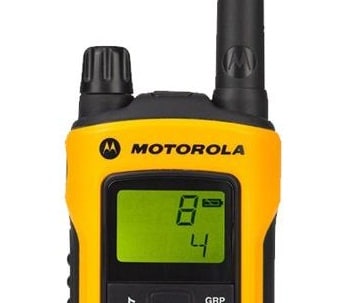
Oddly enough, Motorola Solutions is not the same Motorola which makes smartphones!
That Motorola is Motorola Mobility. They used to be the same company, Motorola, Inc., until the company split into two in 2011.
Motorola Solutions is the legal successor of the original Motorola, Inc. and is the producer of many consumer two-way radios.
They also produce both small-scale and large-scale radio systems for US government operations. In fact, Motorola was an original pioneer into radio research.
We wouldn’t have handheld radios if it wasn’t for Motorola.
Their technological expertise surpasses walkie talkies, though. They set up communication services all over the world. Motorola is also a leader in advanced video surveillance, for better or for worse.
Various industries such as mines and hospitals all use Motorola’s products to keep people communicating over long distances.
Midland USA
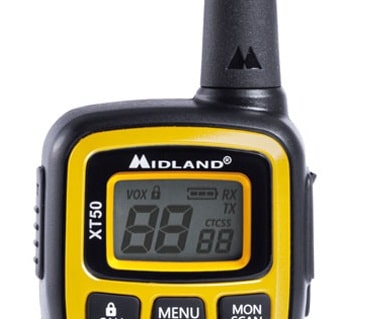
Another pioneering radio company, Midland USA was responsible for bringing CB radios to the public. They also made great strides into FRS technology.
Their focus is not in large-scale communications systems. Instead, Midland supplies radios to the smaller guys; farms large and small use Midland radios.
They are also popular amongst people who need durable and long-range outdoor radios. Campers, hunters, and survivalists all use M
The US military uses walkie talkies, but they are different from the ones usable by civilians.
For starters, they use vastly different frequency bands than FRS/GMRS, often in the 138–144 and 225–400 MHz bands. They also use special military radios such as the Motorola SRX 2200, which are generally not for sale to civilians.
You can monitor military traffic with some receivers, but unless you’re in the military yourself, transmitting on them is a bad idea.
idland radios.
Midland is also partially responsible for the proliferation of NOAA-weather-compatible radios, which are a great boon to anybody who is spending more than a brief moment outdoors.
F.A.Q.
How do I find the right radio frequency?
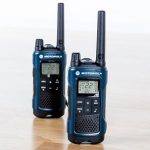
In this day and age, finding the right frequency is easy with most walkie talkies.
Channels 1–7 are GMRS, 8–14 are FRS, and 15–22 are GMRS again. This has been standardized, though you can still find the occasional non-standard holdout.
In that case, you’ll need to look up the FCC frequency standards for the channel to which you want to connect and compare them to your radio’s user manual. You’ll be able to connect to the right channel.
What two-way radios do the military use?
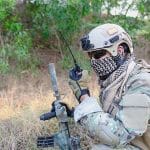
The US military uses walkie talkies, but they are different from the ones usable by civilians.
For starters, they use vastly different frequency bands than FRS/GMRS, often in the 138–144 and 225–400 MHz bands. They also use special military radios such as the Motorola SRX 2200, which are generally not for sale to civilians.
You can monitor military traffic with some receivers, but unless you’re in the military yourself, transmitting on them is a bad idea.
Do walkie talkies work on airplanes or cruise ships, and are they allowed there in the first place?
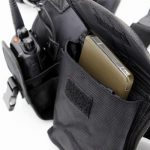
Walkie talkies do work in large, enclosed vehicles such as airplanes and cruise ships. They may have trouble with dense cabins in the middle of ships, but many people use them to keep in touch with their family.
As for aircraft, they might work within the plane, but it’s very illegal. You won’t be able to communicate with people outside the plane because the plane’s body will function as a Faraday cage and block the signal.
My recommendation is to take out the battery, store the it in your luggage, and save it for the mountains!
After you have purchased your new radio, you should also get familiar with walkie talkie lingo.
Or if you want more range than a regular walkie talkie provides check out our handheld ham radio guide



